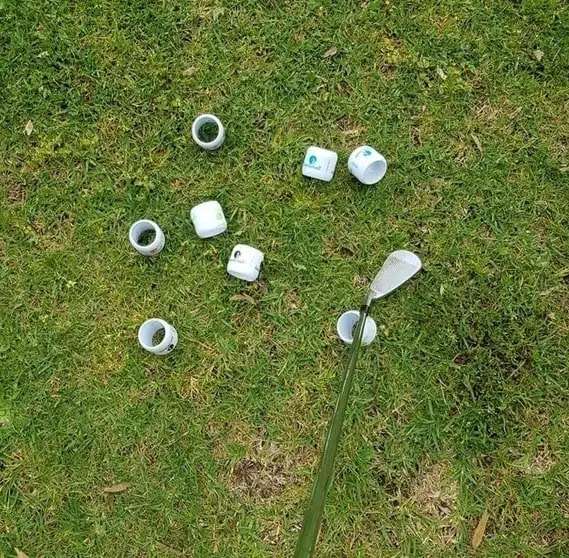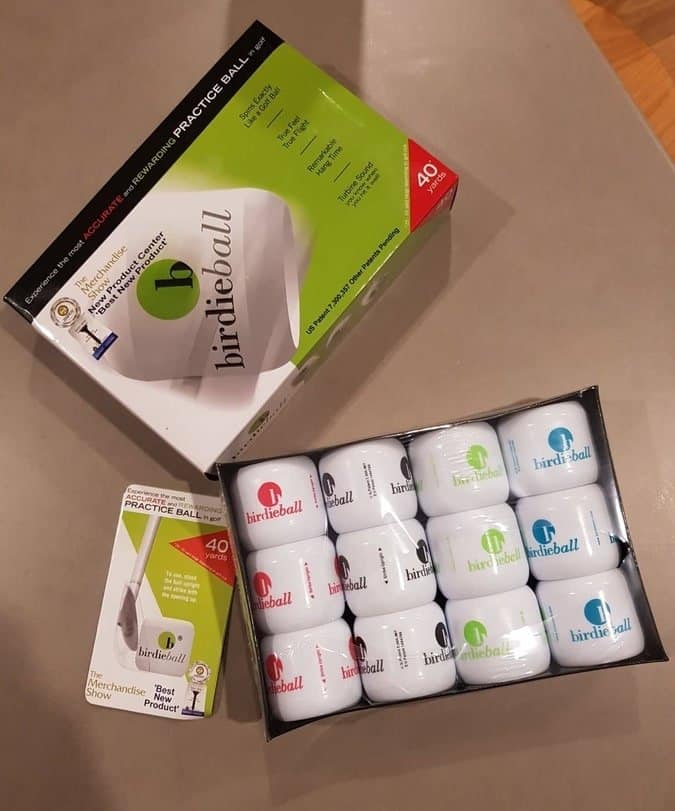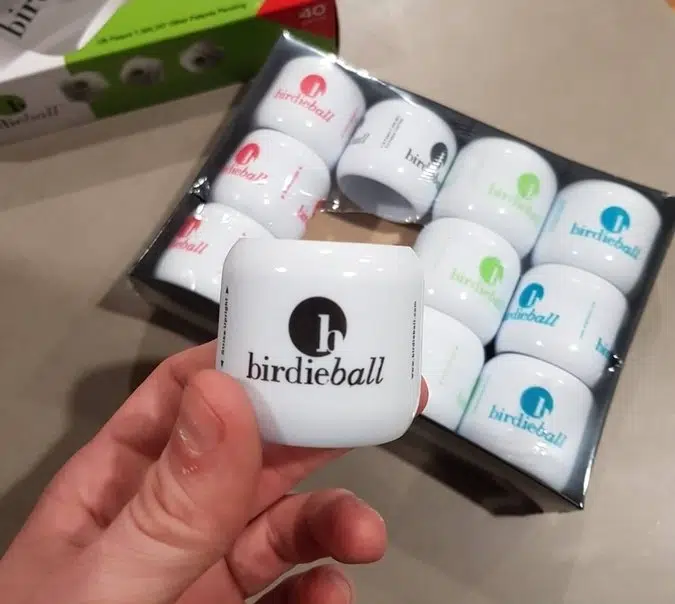The BirdieBall is described as a PGA award-winning, limited-flight practice golf ball – so, I decided to put it to the test and find out for myself.
Honestly, I had never really heard of the BirdieBall until recently.
I’d seen the Facebook ads and catchy sales video all over my news feed, but the odd shape and design of the balls (they look more like a squid ring than a golf ball) always put me off.
However, it wasn’t until I was contacted by BirdieBall’s Australian distributor asking why we’d omitted it from our recommended list of products in an article discussing the value of limited-flight practice balls as a training aid that I began to do my own research.
The team was kind enough to send me a 12-pack of BirdieBalls to test on the proviso that my review of them would be unfiltered, honest and objective, which is exactly what this article is.
So, having whacked a few around my local park, I’m ready to give my thoughts on whether these practice balls are worth buying or not.
But before we get to the nuts and bolts of the review, let’s answer a few common questions you might have about the BirdieBall.
Table of contents
What is a BirdieBall?
According to their website, the BirdieBall is a limited-flight practice golf ball that you can hit “just about anywhere. It has a limited flight distance of 40 metres, but it feels and flies just like a real golf ball. BirdieBall draws and fades, but with a limited range so you can practice golf in the park, oval or backyard”.
Effectively, the BirdieBall is an alternative choice to the Almost Golf or Shaun Webb practice balls, which are the other two popular limited-flight choices on the market.
It is priced similarly to its competitors, with a 12-pack costing around $60 AUD ($43 USD) from Amazon.
But does the BirdieBall perform well enough to truly compete with these other products, and deliver on what it promised in its sales pitch? Let’s take a look.
How do you use a Birdieball?
The BirdieBall is extremely easy to use. Simply place it on the ground so that the hollow opening is pointed to the sky and make sure it’s on a flat surface. Then, choose your club and swing like you would a normal golf ball. If hit correctly, it will fly straight and make a whirring noise through the air.
I tested the BirdieBall using wedges, short irons, mid irons, long irons and also a 3-wood and can safely say the best results I got were with the shorter clubs, as I’ve explained below.
The one big drawback of the BirdieBall is that due to its hollow centre, you can’t place it on a tee – meaning you can’t use driver when hitting it.
While this isn’t a deal breaker (and you probably shouldn’t be using driver with limited-flight practice balls anyway), it does put it behind the Almost Golf and Shaun Webb foam balls in this category.

How does the BirdieBall look at address?
Honestly, when I took my first look at the BirdieBall I thought its cube-like, hollow shape would put me off when standing over it to take my first shot, but I was surprised at how little it bothered me.
While it’s a bit strange to glance down and see grass in the middle of the ball, the BirdieBall makes up for this by having a large surface area in which you make contact with it.
It may look very unusual and different to a normal golf ball when standing over it initially, but I didn’t find this to be too off-putting once I hit a few and found my rhythm (I actually flushed my first few wedges).
How does the BirdieBall feel off the clubface?
The BirdieBall gave great feedback when being struck by the golf club, but reacted very differently to a real golf ball.
I could clearly feel the difference between a poor and solid strike, especially as I moved up through the longer irons and into my 3-wood, however the sensation off the clubface was far lighter and softer than you get from using a tour-quality Titleist Pro V1 or Callaway Chrome Soft.
Instead of that solid ‘thwack’ sound and feel I’m used to when compressing a real golf ball, the BirdieBall didn’t really respond that way – while I still made my usual divot from striking slightly downward with my irons, the plastic ‘twang’ sensation off the clubface was noticeable.
In fact, it got more and more noticeable as I progressed to hitting the longer clubs, with the 3-wood not feeling very good at all.
Also, if you top the BirdieBall or hit it fat, it behaves exactly like any other golf ball does and gives you a poor result.
If I was to practice with the BirdieBall regularly in future, I’d leave my woods at home and only use short-to-mid irons (nothing higher than a 7-iron) as these, by far, felt the best.
How does the BirdieBall fly through the air?
Watching the BirdieBall’s flight once it left the clubface was without doubt the most enjoyable and intriguing parts of my practice session.
When struck well, the BirdieBall would take-off on a penetrating launch angle, much like a real golf ball would, before rising steeply into the air and then dropping almost vertically – like a nose dive – into the ground.
A good strike would make the ball spin end-over-end (which you could clearly see during flight) and generate a distinctive whirring noise caused by air passing through its hollow centre, offering great visual and audible feedback that I’d made solid, square contact.
The manufacturer says the BirdieBall’s flight is limited to 40 metres and I found this to be pretty accurate – but one interesting thing I noticed is that regardless of the club I was using, I struggled to get it to travel farther than this.
Even my best-struck 3-wood took off like a rocket, before rising sharply in predictable fashion and then falling gently out of the sky no more than 50 metres from where I was standing.
YouTube golf personality Mr Short Game demonstrated how the BirdieBall flies through the air in an informative video you can watch here.
Can you shape the BirdieBall through the air?
Another key selling point the manufacturer likes to spruik about the BirdieBall is that the player can fade or draw it through the air, just as you would a regular golf ball.
I found it difficult to hit huge hooks or slices using the BirdieBall during my practice session, but it did respond when I tried to move it left or right in flight.
There was certainly enough shape through the air to give me feedback on whether any given shot would’ve been a massive pull or slice if playing with a regular ball on the course (despite the limited flight), which allowed me to adjust my clubface or path accordingly for the next shot.
This was the most valuable element I found to using the BirdieBall – it moved enough through the air to tell me what kind of shot shape I had hit, but didn’t travel far enough to put the neighbours’ houses at risk or leave me with a long hike to retrieve the ball.
Does the BirdieBall work?
Yes, the BirdieBall works perfectly fine as a limited-flight practice ball. While it pales in comparison to using a regular golf ball, or even range ball, it provides good feedback on quality of strike, has decent shot shaping capabilities and lets you feel whether you’ve struck the ball thin, fat, solid or with draw/fade curvature.
While I certainly enjoyed using them, I can guarantee younger children – especially those under the age of 10 – would have an absolute blast whacking BirdieBalls at home.
If you have a child who is keen to get into golf, but you’re worried about the damage they may cause by hitting real golf balls, the BirdieBall would be the perfect introductory ball that will help teach them the fundamentals of the game (only without the broken windows).

Verdict: Is the BirdieBall worth buying?
The BirdieBall is a great practice ball if you’re someone who doesn’t have access to a proper driving range or golf course nearby; has limited space to hit golf balls in (such as a football field); or wants to develop their club path/clubface control without spending lots of money.
Personally, I enjoyed hitting the Birdieballs around my local park but couldn’t help feel restricted by how much value I could truly extract from them.
If I really wanted a serious practice session – especially one that involved hitting different shot shapes and working on the quality of my ball-striking – spending time at the driving range, or hitting balls on my own at my local course, would be of greater benefit.
But for the purpose of having some fun in my spare time, without having to spend money on a bucket of range balls, the BirdieBall delivered on everything promised.
They were fun to use, restricted the flight of the ball enough that I could hit them in a small grassy field, and could be shaped through the air (enough to give good feedback on clubface control and path).
Whether you’re looking to buy a pack of BirdieBalls to use in your own backyard, or perhaps as a gift for a friend or family member (especially kids), you can do so with confidence knowing these are an entertaining training aid that will provide plenty of enjoyment.
However, if you’re a serious golfer, I’d suggest maybe dedicating more time to honing your skills at the driving range as doing so will provide a better return on investment than what you’ll get from the BirdieBall.
- TaylorMade SIM2 Max Driver vs M4 Driver: Worth it in 2024? - April 15, 2024
- 3 Ways to Win the Mental Game with the Bridgestone Mindset Golf Ball - March 29, 2024
- TaylorMade SIM Max & SIM2 Max Drivers: Are they Still Relevant in 2024? - March 9, 2024

